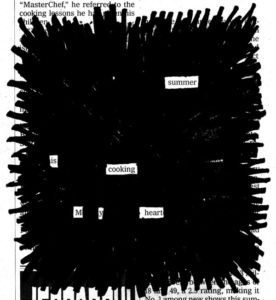In the poem “Floodsong 2: Water Moccasin’s Spiritual,” Douglas Kearney begins with the familiar refrain of the song “Wade in the Water,” which we have read and listened to many times in class. The first two refrains resemble the song we heard in class: “wade in the water / wade in the water, children / wade in the water / god’s gon’ trouble the water.” After that, however, the familiar verses seem to fall apart. Meaning shifts as words disappear and reappear. To me, the poem takes on a feeling of urgency or even panic: “children / gon’ / in the water / trouble / in the water / trouble / in the water.”
This poem reminds me of the practice of “blackout poetry,” a popular exercise in which a poet takes a piece of existing text—the page of a book or a newspaper article—and blacks out the majority of the words until only their chosen words remain, building a poem through elimination. Here is an example:

Kearney’s “Floodsong 2” resembles “blackout poetry” in a way, as he creates new meaning through the elimination of words from an existing text. However, Kearney does not use black bars or cross-outs to mark the eliminated text; rather, there is only white space where the missing words were. I guess you could call this a kind of “white-out poetry,” a quieter process of elimination, as if the water moccasin is moving through the poem and swallowing words whole. The poem ends on what feels like an incomplete thought—“water / water / water / god’s gon’”—as if the speaker was cut-off before they could finish their sentence.
This may seem like a random transition, but the white space of Kearney’s poem reminded me of the phrase “white-washing,” which is common in modern Northern Irish poetry, dealing with the violence of The Troubles in Northern Ireland. “White-washing” was a term used to describe the ways violence was simply covered up, or painted over—a way of ignoring atrocity without engaging in it. The white spaces in Kearney’s “Floodsong 2” seem to call readers’ attention to what has been lost or erased, however passively. In her essay “Possession” which we read on our first day of class, Suzan-Lori Parks describes her work as “creating history where it is and always was but has not yet been divined” (5). Parks is writing stories from a history which has largely been erased or white-washed, trauma which has been packaged away without ever really being unpacked. I wonder if Kearney’s poem is using white space and elimination to make a similar point about the erosion or erasure of African-American culture.
As we’ve been encouraged to connect these poems to the other seemingly-random ideas we’ve been engaging with, I’ll say that I’ve been thinking a lot about unexamined consumption. After keeping a food journal, I realized that I rarely consider where my food is coming from or where its leftovers will go. I am a senior at Geneseo and I never knew where our heat came from until this morning’s visit to the heating plant. In my first blog post I set the intention to think more consciously about language, about what sockets I am being “plugged into” without my consent. In the same way, I realize I am part of a multitude of systems—big machines, even—that I never question or even acknowledge. “Floodsong 2” has left me thinking a lot about absence and exclusion, and how I may be caught in systems which contribute to these silent “white-outs.”
